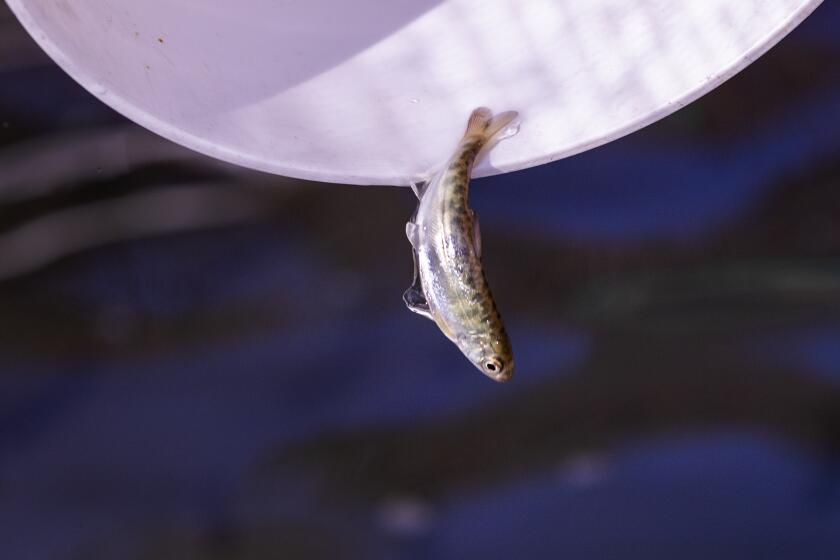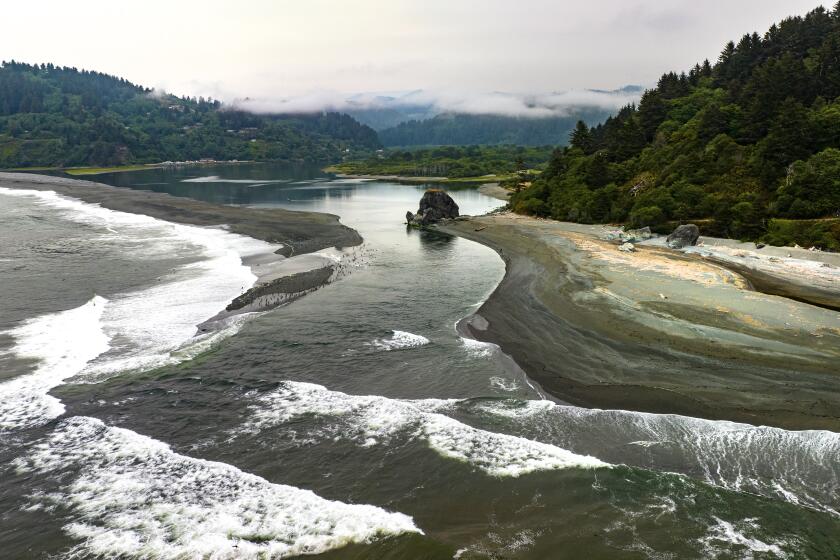- Share via
Typically, now is the time when creeks along the Sacramento River are filled with young spring-run Chinook salmon preparing to make their journey downstream to the Pacific Ocean, where they will mature, and eventually make their return to California spawning sites.
This year, however, the salmon population has plummeted alarmingly — what officials call a “cohort collapse” — and biologists are taking urgent measures to save them from extinction.
For the first time, biologists with the California Department of Fish and Wildlife and the National Oceanic and Atmospheric Administration have begun capturing the juvenile spring-run salmon so that they can breed them in captivity, and hopefully prevent them from disappearing from the wild.
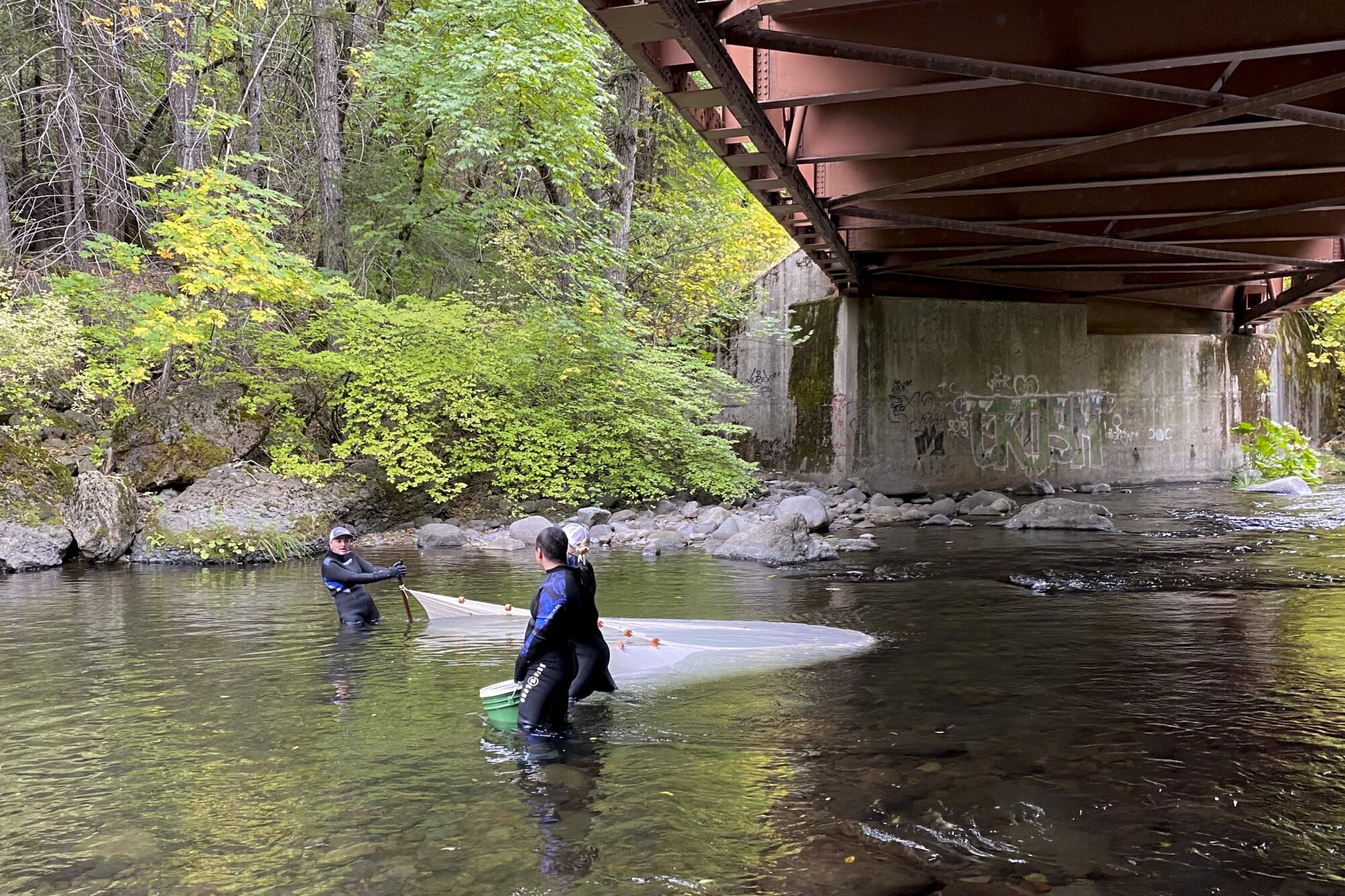
“We have a rare opportunity to make a bold decision in advance to try to preserve wild, independent populations,” said Jason Roberts, an environmental program manager for the department. “It was super urgent to take this action now.”
In the last several days, biologists have been using nets to capture small salmon in Deer Creek, a tributary of the Sacramento River. From there, they have transported them by truck, in an aerated tank on a trailer, to the UC Davis fish laboratory.
Deer Creek, along with Mill Creek and Butte Creek, support the remaining wild populations of spring-run Chinook that make their way upriver to spawn each year.
Salmon once thrived in rivers across the Central Valley but suffered major declines over the last century as the construction of dams cut them off from spawning habitats. Since 1999, the spring-run Chinook population has been listed as threatened under the federal Endangered Species Act.
Scientists say the fish are now suffering because of successive droughts intensified by climate change, along with other pressures, such as the large amounts of water diverted from rivers to supply California’s farms and cities.
Two decades ago, thousands of spring-run Chinook came to spawn in Deer Creek and Mill Creek near Red Bluff. In recent years, the numbers of fish returning to these creeks has been in the hundreds.
“If we lost those populations, that would break our connection with wild salmon populations in the Central Valley that have thrived for thousands of the years,” said Brian Ellrott, NOAA Fisheries’ salmon recovery coordinator.
State records show that last year, biologists found 397 returning adult spring-run salmon in Deer Creek and 250 adults in Mill Creek. This year, Ellrott said, biologists have found only 22 adult fish in Deer Creek, and just seven fish in Mill Creek.
The population crash prompted biologists to develop a rescue plan, or what officials call a “safety net.”
As dams and global warming push endangered California salmon to the brink, a rescue plan is taking shape — and a tribe pushes for recovering their sacred fish.
“We are running out of options,” said Cathy Marcinkevage, assistant regional administrator for NOAA Fisheries. “We want this species to thrive in the wild, but right now we are worried about losing them.”
Since last week, biologists have captured about 300 fish. The salmon are nearly a year old — close to the age when they typically head downstream to the Sacramento-San Joaquin River Delta and San Francisco Bay on their journey to the Pacific.
Salmon typically live 3 or 4 years. The severe drought from 2019 to 2022 has affected multiple spawning years, putting the fish in peril.
State and federal officials say they will capture juvenile fish from the three creeks that have served as the last strongholds for spring-run salmon. They plan to keep the captive fish at UC Davis’ Center for Aquatic Biology and Aquaculture for the next two years, while they decide where to put them on a longer-term basis.
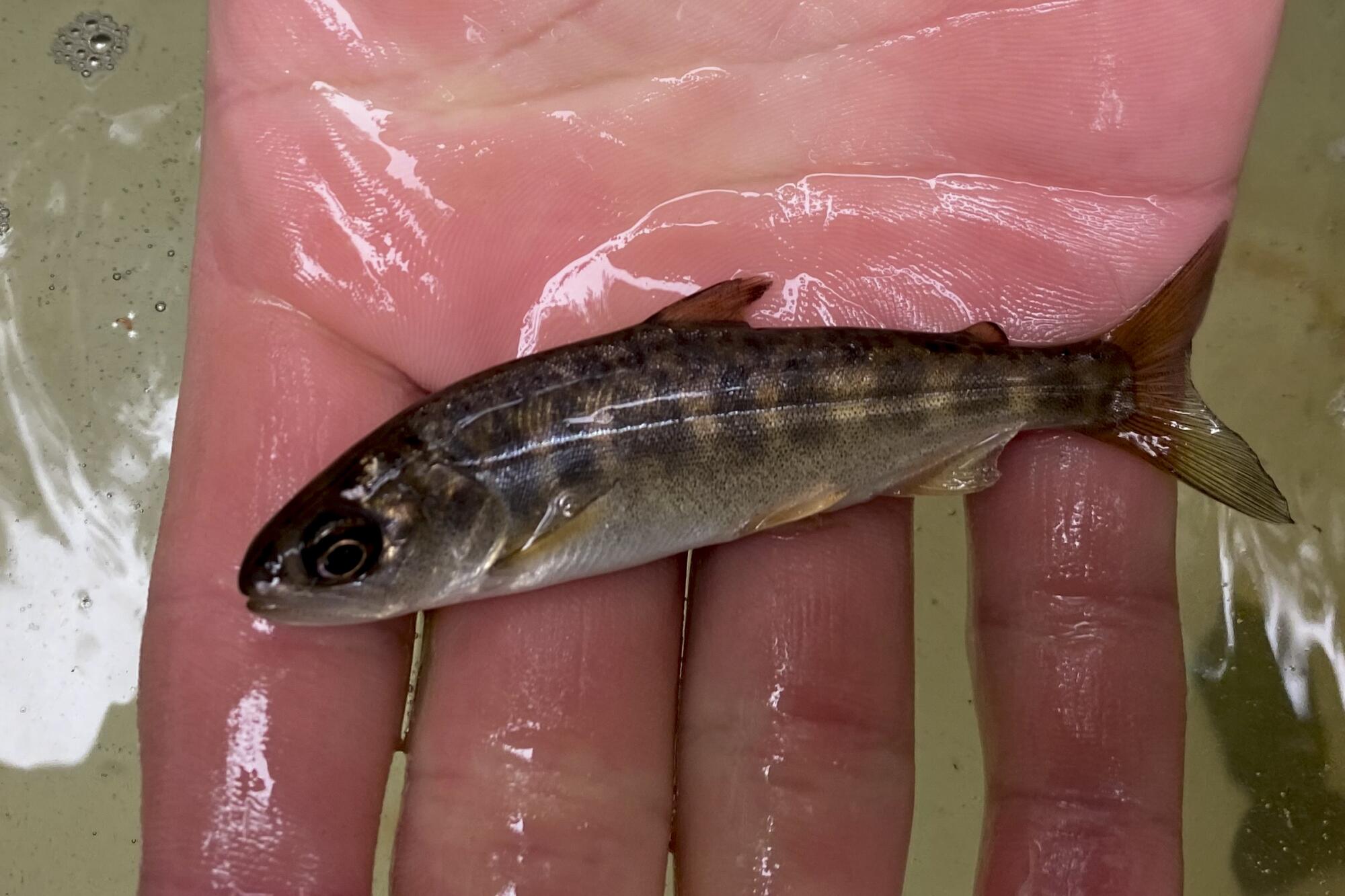
The goal is to raise the fish to maturity until spawning, and then take the eggs back to the same creeks so that the next generation can help boost the population, Ellrott said. He said rebuilding the salmon numbers in these creeks will be vital to preserving their genetic diversity.
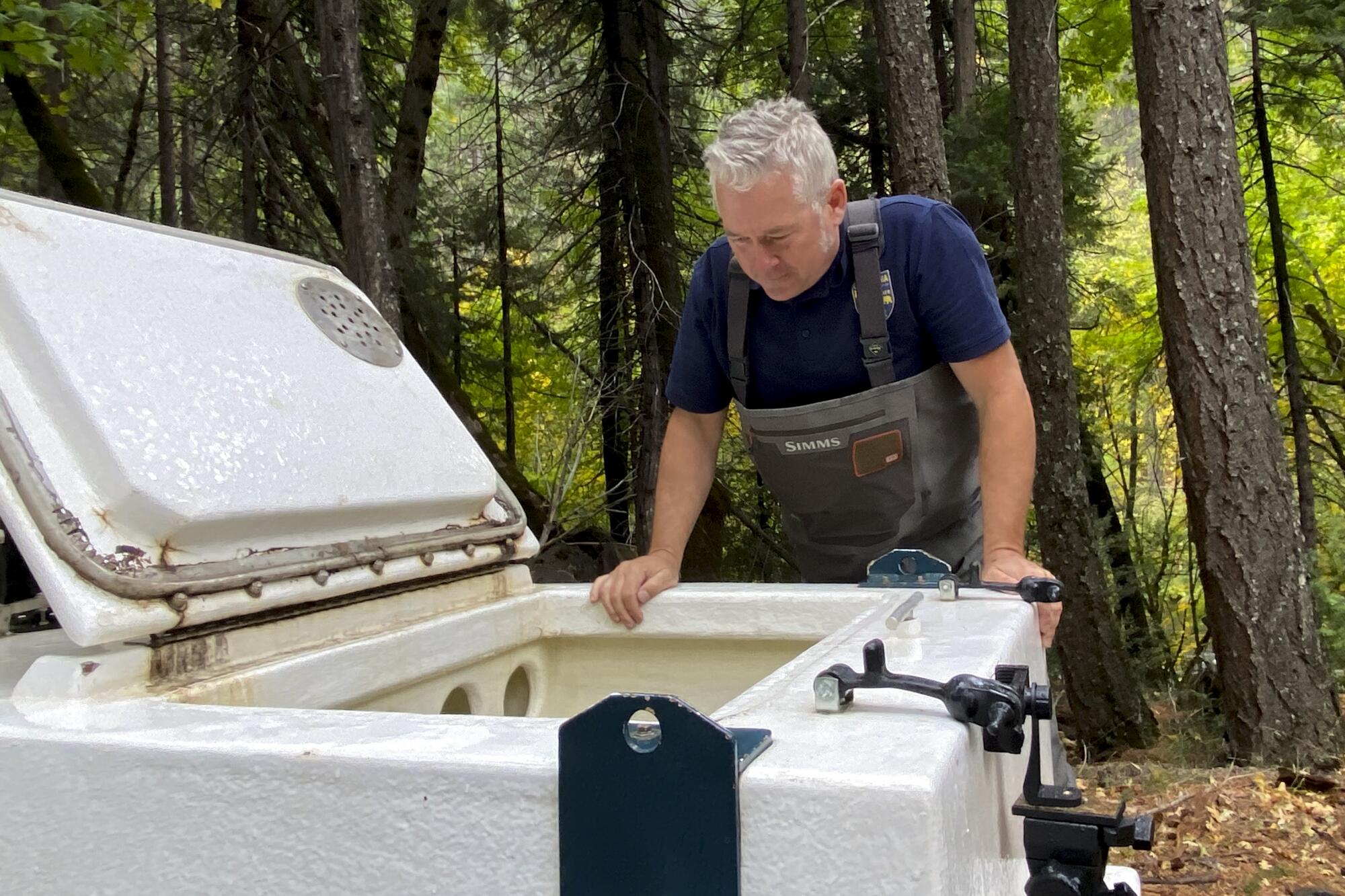
Scientists name distinct populations of Sacramento River salmon after the season they return from the Pacific, and track their numbers closely. Winter-run Chinook are endangered. The more numerous fall-run and late-fall-run Chinook usually support commercial and recreational fisheries. But this year, those populations declined so low that the fishing season was shut down along the coast.
Spring-run Chinook head to their ancestral streams every year in early spring, where they find deep pools and remain until the summer. In September and October, they spawn and die.
Some of the juvenile fish hatch and swim downstream, while others remain for a year. Those “yearlings” are the fish that biologists have been wading into creeks to capture.
“Ongoing multiyear droughts and persistent climate change, in addition to how we manage water in California, has made it really hard for Chinook salmon to recover, particularly spring-run,” Roberts said. “These are just fish that have been persistently caught in a drought cycle.”
Winter-run Chinook salmon numbers are at the lowest they’ve ever been. But scientists say it’s not because of high temperatures or the historic drought. Instead, they say, it’s their diet.
Roberts and others said the numbers of returning spring-run salmon could turn out to be the lowest ever recorded. Scientists track the numbers using underwater video as well as surveys — both walking and snorkeling — along the creeks.
Environmental and fishing groups have blamed state and federal water management policies for declining salmon numbers. Salmon advocates insist dams are operated in ways that harm Chinook salmon by denying them life-sustaining flows of cold water.
“During the last few years, spring-run Chinook have continued to be exposed to harmful water temperatures and just dangerously low water flows,” said Scott Artis, executive director of the Golden State Salmon Assn.
Artis said he and other salmon advocates applaud the state and federal agencies for starting the rescue program. However, he said the current situation could have been avoided if the federal Bureau of Reclamation and other agencies focused on the biological needs of salmon, instead of catering to “thirsty industrial agriculture.”
Along with the effects of California’s driest three years on record from 2019 to 2022, salmon have been weakened by thiamine deficiency, which scientists believe is linked to an increase in anchovies in their ocean diet.
In 2021, many returning adult fish died before they could spawn. Scientists said warm water temperatures and thiamine deficiency fueled a disease outbreak among the fish.
Another blow came this summer, when a breach in Pacific Gas & Electric’s Butte Canal sent a rust-colored sediment spill coursing into Butte Creek. The company said in a written statement that it acted quickly to stop water flows in the canal, and has worked to minimize impacts to the creek and wildlife.
State and federal officials say the incident is under investigation.
Native activists fought for years to build support for taking down dams on the Klamath River in Northern California. Now, they hope removing the dams will help save their salmon.
“There is huge concern that the spring-run population in Butte Creek was heavily impacted by the sediment spill,” Ellrott said.
The National Marine Fisheries Service has submitted a report to the Federal Energy Regulatory Commission saying PG&E failed to comply with its license. It raised concerns that high levels of sediment in the water “created lethal conditions” for spring-run Chinook.
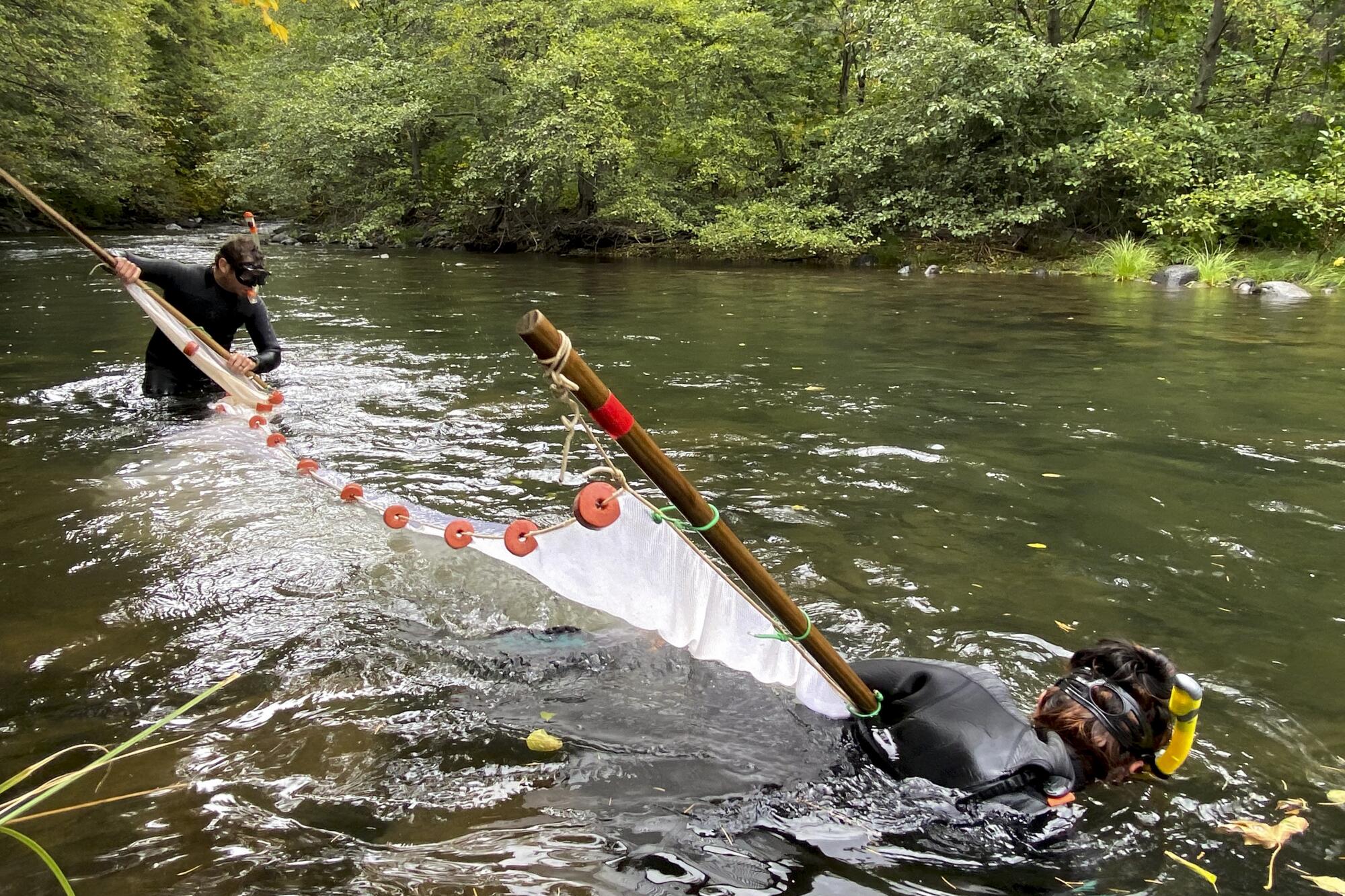
This month’s rescue operation will expand California’s efforts to conserve several types of salmon by rearing fish at hatcheries.
Government scientists have also been discussing the possibility of reclassifying spring-run Chinook as endangered.
Chuck Bonham, director of the Department of Fish and Wildife, said the drastically low numbers of salmon this year “come at a time when we’ve already been taking extreme measures to protect salmon strongholds and eliminate existing barriers keeping them from their historic habitat.”
“We’ve got to continue to do everything we can to preserve these iconic fish,” Bonham said.
Spring-run Chinook historically were “specialists in exploiting these very high elevation, super cold water systems that were really hard to get to,” said Andrew Rypel, a professor of fish ecology and director of UC Davis’ Center for Watershed Sciences. Now, dams keep them from most of those habitats.
In a wet year like 2023, an estimated 15% to 20% of the young salmon typically survive the migration to the ocean, he said. But in a drought year, that drops to 3% or nearly zero.
“Drought is really hard on these fish,” Rypel said. “And the adults that are coming back this year, even though we’re kind of out of the drought, these are all fish that were born in the middle of the drought.”
You're reading Boiling Point
Sammy Roth gets you up to speed on climate change, energy and the environment. Sign up to get it in your inbox twice a week.
You may occasionally receive promotional content from the Los Angeles Times.


